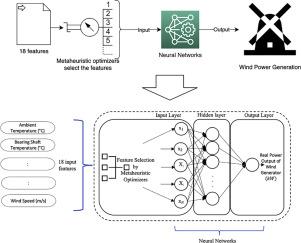Wind power forecasting with metaheuristic-based feature selection and neural networks
引用次数: 0
Abstract
Accurate forecasting of wind power generation is crucial for ensuring a stable and efficient energy supply, reducing the environmental impact of energy production, and promoting a cleaner and more sustainable energy supply. Inaccurate forecasts can lead to a mismatch between wind power generation and energy demand, resulting in wasted energy, increased emissions, and reduced grid stability. Therefore, improving the accuracy of wind power generation forecasting is essential for optimizing energy storage and grid management, reducing the reliance on fossil fuels, decreasing greenhouse gas emissions, and promoting a more sustainable energy future. This study proposes an innovative approach to enhance wind power generation forecasting accuracy by leveraging the strengths of metaheuristic algorithms for feature selection and integrating them with Neural Networks (NN). Specifically, five distinct algorithms - Genetic Algorithm (GA), Particle Swarm Optimization (PSO), Ant Colony Optimization (ACO), Teaching-Learning-Based Optimization (TLBO), and Evolutionary Mating Algorithm (EMA) - are integrated with NN model to identify optimal feature subsets from a comprehensive dataset of 18 diverse features. The results show that the GA consistently outperforms other algorithms in selecting the most influential features, leading to improved precision in wind power predictions. Notably, the GA achieves the best root mean square error (RMSE) of 37.1837 and the best mean absolute error (MAE) of 18.6313, outperforming the other algorithms and demonstrating the importance of feature selection in improving the accuracy of wind power forecasting. This innovative framework advances the field of renewable energy forecasting and provides valuable insights into optimizing feature sets for improved predictions across diverse domains.

利用基于元搜索的特征选择和神经网络进行风能预测
准确预测风力发电量对于确保稳定高效的能源供应、减少能源生产对环境的影响以及促进更清洁、更可持续的能源供应至关重要。不准确的预测会导致风力发电与能源需求不匹配,造成能源浪费、排放增加和电网稳定性降低。因此,提高风力发电预测的准确性对于优化能源存储和电网管理、减少对化石燃料的依赖、减少温室气体排放以及促进更可持续的能源未来至关重要。本研究提出了一种创新方法,利用元启发式算法的优势进行特征选择,并将其与神经网络(NN)相结合,从而提高风力发电预测的准确性。具体来说,五种不同的算法--遗传算法(GA)、粒子群优化(PSO)、蚁群优化(ACO)、基于教学学习的优化(TLBO)和进化交配算法(EMA)--与神经网络模型相结合,从包含 18 种不同特征的综合数据集中识别出最佳特征子集。结果表明,在选择最有影响力的特征方面,GA 始终优于其他算法,从而提高了风能预测的精度。值得注意的是,GA 的最佳均方根误差 (RMSE) 为 37.1837,最佳平均绝对误差 (MAE) 为 18.6313,优于其他算法,证明了特征选择在提高风力预测精度方面的重要性。这一创新框架推动了可再生能源预测领域的发展,并为优化特征集以改进不同领域的预测提供了宝贵的见解。
本文章由计算机程序翻译,如有差异,请以英文原文为准。
求助全文
约1分钟内获得全文
求助全文

 求助内容:
求助内容: 应助结果提醒方式:
应助结果提醒方式:


